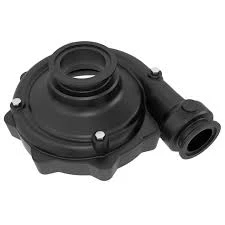Mobile:+86-311-808-126-83
Email:info@ydcastings.com
Understanding the Functionality and Design of Impeller Casings in Pumps
Understanding Impeller Casing An Essential Component in Fluid Dynamics
In the realm of fluid dynamics, the design and efficiency of pumping and propulsion systems are critically dependent on various components, among which the impeller casing plays a pivotal role. The impeller casing, often referred to as the volute or casing, surrounds the impeller and serves multiple essential functions in both centrifugal pumps and turbines. Understanding the significance, design considerations, and operational impacts of impeller casings is crucial for engineers and designers working in hydraulic systems.
What is Impeller Casing?
The impeller casing is the outer shell that encases the impeller, which is the rotating component responsible for imparting energy to the fluid being moved. In centrifugal pumps, as the impeller spins, it creates a significant velocity increase in the fluid, which is then converted to pressure as the fluid exits the impeller and enters the casing. The design of the casing is critical because it not only directs fluid flow but also helps to minimize energy losses and optimize performance.
Functions of Impeller Casing
1. Flow Direction One of the primary roles of the impeller casing is to guide the flow of fluid from the impeller to the exit. The shape of the casing, often circular or spiral, helps to smoothly transition the high-velocity flow from the impeller to a lower velocity, higher pressure flow as it exits the pump or turbine.
2. Pressure Conversion The casing helps convert the high kinetic energy generated by the impeller into pressure energy, which is essential for moving fluids through pipelines or systems against various pressures.
3. Minimizing Cavitation Proper design of the casing is crucial in preventing cavitation, a phenomenon where vapor bubbles form and collapse in regions of low pressure. Cavitation can cause significant damage to the impeller and casing, reducing efficiency and lifespan.
Design Considerations
impeller casing

The design of an impeller casing involves careful consideration of several factors
1. Geometry The shape of the casing should facilitate smooth fluid flow while minimizing turbulence. Engineers often employ computational fluid dynamics (CFD) simulations to optimize the casing’s geometry for desired performance.
2. Material Selection Given that impeller casings are subjected to various stresses, temperature changes, and potential corrosive fluids, the choice of materials is crucial. Common materials include cast iron, stainless steel, and various alloys, selected based on the application and fluid characteristics.
3. Size and Scale The size of the casing must match the intended application, whether for small domestic pumps or large industrial systems. Scaling impacts not only efficiency but also reliability and maintenance requirements.
4. Surface Finish The internal surface finish of the casing can significantly affect flow characteristics, potentially leading to improved efficiency. Smooth surfaces reduce drag against the fluid, while rough surfaces can promote turbulence and inefficiencies.
Operational Impact
The design and quality of the impeller casing directly influence the operational efficiency of pumps and turbines. An optimal casing can enhance the performance of the entire system, reduce energy consumption, and extend the service life of equipment. Conversely, poorly designed casings can lead to inefficiencies, increased wear, and the risk of mechanical failures, resulting in costly downtimes and repairs.
Conclusion
In summary, the impeller casing is a critical component that significantly impacts the performance of centrifugal pumps and turbines. Its design must balance the need for efficient flow dynamics, structural integrity, and material resilience. As technology advances, ongoing research and development in fluid dynamics and materials science will lead to improved casing designs, enhancing system efficiency and reliability. For engineers in the field, a thorough understanding of impeller casing design principles and their implications is essential for optimizing hydraulic systems and ensuring their successful operation.
-
Why Should You Invest in Superior Pump Castings for Your Equipment?NewsJun.09,2025
-
Unlock Performance Potential with Stainless Impellers and Aluminum End CapsNewsJun.09,2025
-
Revolutionize Your Machinery with Superior Cast Iron and Aluminum ComponentsNewsJun.09,2025
-
Revolutionize Fluid Dynamics with Premium Pump ComponentsNewsJun.09,2025
-
Optimizing Industrial Systems with Essential Valve ComponentsNewsJun.09,2025
-
Elevate Grid Efficiency with High-Precision Power CastingsNewsJun.09,2025











